Do you know 75% of internet users never scroll past the first page of search results? This means if your store isn’t ranking well, three-quarters of potential customers will never see your products. Organic search accounts for 53% of all site traffic, making it the most powerful channel for reaching new customers. When comparing effectiveness, SEO-generated inbound leads close at an impressive 14.6%, while traditional methods like mail advertisements only convert at 1.7%.
Most online shopping journeys begin with a simple Google search. This is why many businesses turn to a specialized BigCommerce SEO agency or seek BigCommerce SEO services to optimize their stores. Whether you manage your SEO in-house or partner with a BigCommerce SEO company, understanding these fundamentals is crucial for success.
Unlike paid advertising, which stops delivering the moment you stop spending, a small investment in SEO for e-commerce provides significant long-term benefits. With billions of searches happening every day, this checklist will help your BigCommerce store capture more of that valuable organic traffic and ultimately boost your sales.
Why SEO Matters for BigCommerce Stores
Organic search remains the primary battleground for e-commerce success in today’s digital marketplace. With studies showing that 32% of online shoppers begin their journey with a search engine, your BigCommerce store’s visibility directly impacts your bottom line.
How SEO Drives Organic Sales
Search engine optimization creates a powerful sales funnel for your BigCommerce store. Robust optimization with carefully chosen keywords helps your website climb higher in search engine rankings, attracting more unpaid traffic because shoppers typically click links at the top.
Furthermore, customers generally view websites in natural search results as more reliable than paid ads. Many shoppers believe these listings earned their positions through quality rather than advertising dollars. This perception of trustworthiness often leads to higher engagement from potential buyers browsing your digital storefront.
This happens because SEO targets visitors actively seeking your products, rather than interrupting them with advertisements.
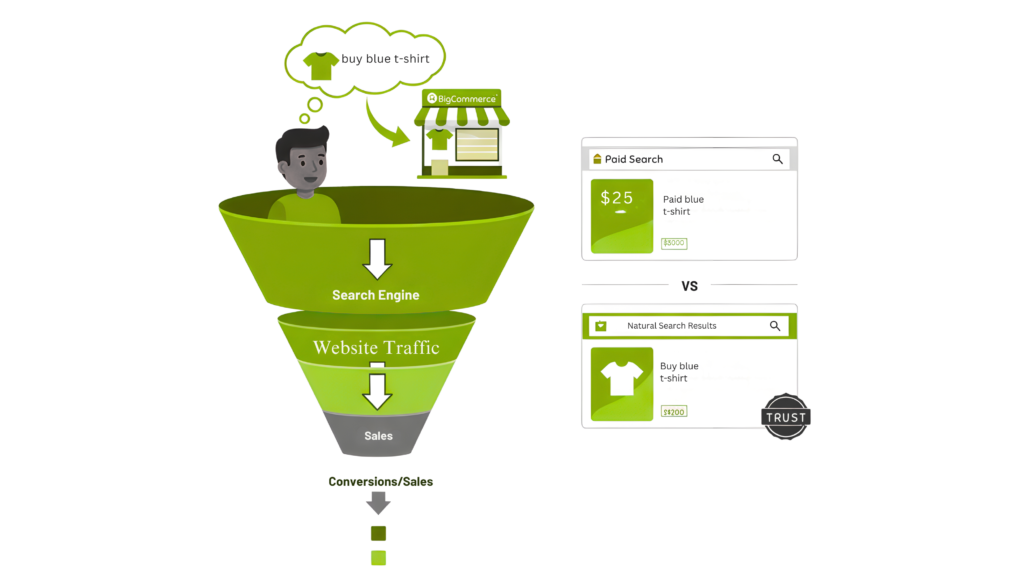
SEO vs Paid Ads: Long-Term ROI
Understanding the cost differences between strategies is essential for e-commerce success. Pay-per-click campaigns deliver quick visibility but require constant financial investment. Conversely, SEO demands upfront work yet provides lasting advantages without needing continuous spending.
For a ₹8,438,045 annual digital marketing budget, SEO can generate ₹4,364,511 in revenue versus ₹1,964,027 from PPC. This difference highlights SEO’s potential for delivering over twice the revenue when given the same financial resources.
Additionally, after achieving strong positions naturally, maintaining them becomes less expensive over time, reducing dependency on ads. Blog content serves as a foundation for creating a durable online presence. While ads stop delivering visitors once funding ends, effective SEO builds lasting traffic sources.
Why BigCommerce Needs a Tailored SEO Approach
BigCommerce offers several built-in SEO features that make it particularly well-suited for optimization. These include customizable URL structures, meta tags, and header tags specifically designed to help merchants optimize their stores for search engines.
Nevertheless, like other e-commerce platforms, BigCommerce has unique characteristics that require specialized optimization.
With over 5.3 billion internet users worldwide (Statista, 2024), search engines are the primary gateway to online purchases. According to BrightEdge, organic search drives 53% of all website traffic—meaning if your BigCommerce store isn’t optimized, you’re missing a huge revenue opportunity.
Here’s why you need a dedicated SEO strategy for BigCommerce:
- High competition: eCommerce niches are crowded; SEO helps you stand out.
- Long-term ROI: Unlike paid ads, organic rankings continue to bring traffic without constant ad spending.
- Better user trust: 75% of users never scroll past the first page of Google (HubSpot, 2023).
Essential On-Page SEO Tactics
On-page optimization forms the foundation of effective SEO for BigCommerce stores. According to studies, well-optimized product pages can significantly increase your chances of ranking higher in search results.

Optimizing Product Titles and Descriptions
Your product titles serve as first impressions for both customers and search engines. For maximum effectiveness, include your primary keyword near the beginning of the title, keep it under 60 characters to prevent truncation in search results, and incorporate your brand name where relevant.
Product descriptions require both strategic and creative approaches. Write at least 300 words of unique content for category pages, naturally incorporating keywords throughout. Avoid using manufacturer-provided generic descriptions, as duplicate content harms your rankings.
Instead, craft descriptions that address customer needs while maintaining a conversational tone—essentially speaking to a friend who knows nothing about your products.
Using Clean and Keyword-Rich URLs
BigCommerce automatically generates SEO-friendly URLs, offering several structure options. The recommended setting is SEO Optimized (Short), which creates clean URLs in the format yourdomain.com/product-name. This format performs better, as research indicates shorter URLs tend to rank higher in Google.
When customizing URLs, follow these practices:
- Use hyphens to separate words instead of underscores
- Include relevant keywords that describe the page content
- Keep URLs concise yet descriptive
- Avoid random numbers or characters
A significant advantage of BigCommerce is its automatic 301 redirects when you rename products, preventing broken links and preserving SEO value.
Crafting Effective Meta Titles and Descriptions
Meta titles appear as clickable links in search results, making them crucial for attracting visitors. For optimal performance, keep titles under 60 characters, place your target keyword near the beginning, and include your brand name.
An example of an effective title format is: “Lavender Scented Candles – ScentsbyJo”.
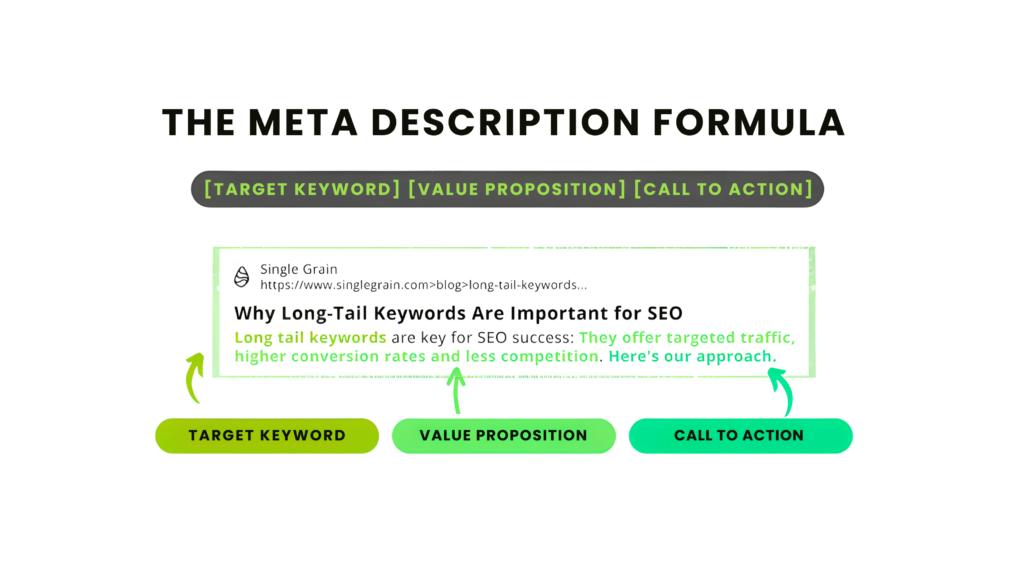
Although meta descriptions aren’t direct ranking factors, they significantly impact click-through rates. Create descriptions under 160 characters that incorporate relevant keywords, which appear bolded in search results. Write compelling copy with clear value propositions or calls-to-action like “Shop now” or “Free shipping.”
Remember that Google doesn’t always use your meta description; sometimes it pulls content directly from your page.
Adding Alt Text to Product Images
Image optimization starts with proper naming before uploading—use descriptive filenames like “black-running-shoes.jpg”. In BigCommerce, add alt text by editing the product and clicking on the images section. Then add text to each image’s description field.
- Alt text serves dual purposes: helping search engines understand images and improving accessibility for visually impaired users. Include your target keywords in alt text when relevant, but prioritize accurate descriptions of the image. This practice helps your products appear in Google image search results, creating another channel for discovery.
- Quality images themselves also matter: BigCommerce recommends product images at 1280 x 1280 pixels. Multiple high-resolution images showing products from various angles can significantly influence purchase decisions.
Implementing these on-page techniques consistently across your BigCommerce store creates a strong foundation for higher rankings.
Technical SEO Checklist for BigCommerce
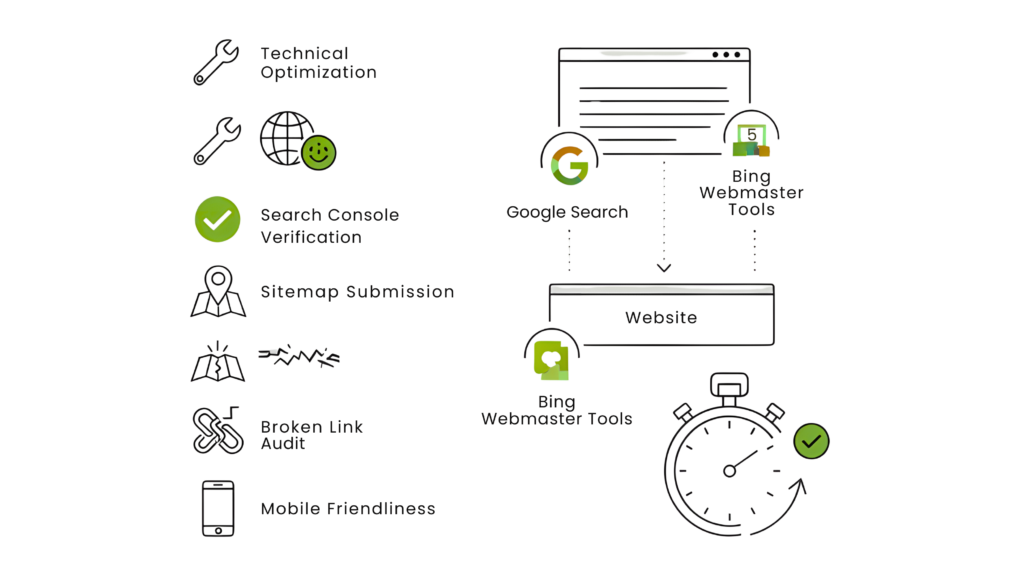
Technical setup forms the backbone of any successful seo for Bigcommerce strategy. First of all, let’s explore the essential technical optimizations that will help your store rank higher and convert better.
Set up Google Search Console and Bing Webmaster Tools
Site verification with search engines allows them to find and index your store while providing valuable performance insights. For Google Search Console, create a free Google account, then add your property using the URL Prefix option. Under verification methods, select HTML Tag, copy the meta tag, and paste it into BigCommerce’s Site Verification Tags section. For Bing, follow a similar process through Bing Webmaster Tools—both platforms are crucial, as Bing receives 3.40% monthly visitors.
Create and Submit an XML Sitemap
Your BigCommerce store automatically generates an XML sitemap at yourdomain.com/xmlsitemap.php. This map helps search engines find, crawl, and index your content efficiently. To submit it to Google, navigate to Search Console’s Sitemaps section and enter “xmlsitemap.php” after your domain.
For Bing, log in to Webmaster Tools, add your site, and submit the same sitemap URL. Remember that your sitemap includes products, categories, brands, and content pages marked as visible.
Ref: Image
Fix Broken Links and Redirect Chains
Broken links create poor user experiences and harm SEO. Regularly audit your site using tools like Google Search Console or Screaming Frog to identify these issues. Statistics show that 70% of users exit a page that returns a 404 error.
BigCommerce automatically creates 301 redirects when you rename products, but you’ll need to manually redirect deleted pages. For footer link issues, edit theme files to use absolute URLs rather than relative ones.
Ensure Mobile Responsiveness
Mobile optimization is essential now that smartphones account for 61.79% of internet usage. Fortunately, all BigCommerce Stencil themes are responsive out-of-the-box. Focus on buttons large enough for thumb-tapping, readable font sizes (at least 16px), and simplified forms for mobile users. Google uses mobile-first indexing, meaning it prioritizes your site’s mobile version when determining rankings.
Improve page speed and Core Web Vitals
Page speed significantly impacts both rankings and conversions—the probability of bounce rates increases by 106% when load time goes from one to six seconds.
Focus on Google’s Core Web Vitals:
- Largest Contentful Paint (under 2.5 seconds)
- First Input Delay (under 100ms)
- Cumulative Layout Shift (under 0.1)
Optimize images by compressing them before uploading, implement asynchronous loading, and minimize third-party scripts. Many merchants partner with a BigCommerce SEO company to address these technical aspects properly.
Content and Keyword Strategy for Growth
Keyword research and strategic content creation form the cornerstone of successful SEO for BigCommerce stores. Most online shoppers (32%) begin their purchase journey through search engines, making a data-driven content approach essential for capturing this traffic.
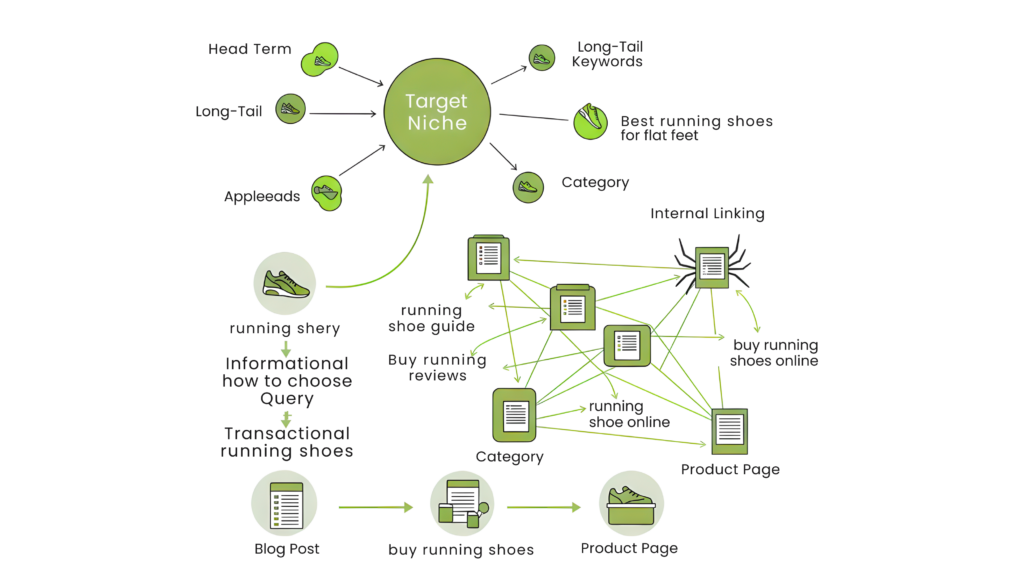
Conduct Keyword Research for Product and Category Pages
The foundation of effective keyword research begins with understanding your customers’ search behavior. Start by creating a targeted list containing both head terms (like “running shoes”) and long-tail phrases (such as “best running shoes for long-distance marathons”). Notably, over 90% of keywords searched are long-tail keywords, which typically convert better due to their specificity.
For BigCommerce stores, focus on keywords with transactional intent that include terms like “buy” or “order” for product pages. Use tools like Google Keyword Planner, SEMRush, or Ahrefs to discover search volume, competition levels, and keyword suggestions.
Moreover, consider using Amazon as a keyword research source, as it reflects actual customer language and purchasing patterns.
Use Blog Content to Target Informational Queries
Blog content creates lasting traffic sources even after paid advertising stops. Develop content that addresses common questions in your niche, focusing on informational keywords (like “how to choose”) that attract customers in research phases.
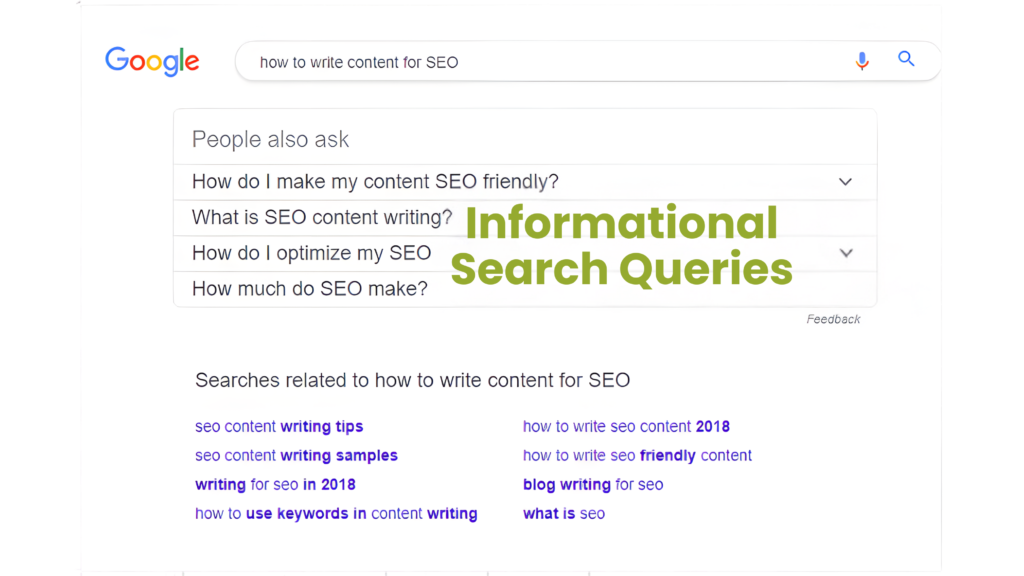
Your blog strategy should include various content types:
- Buying and gift guides that target transactional keywords
- Comparison posts for long-tail keywords
- “Best of” product roundups
- FAQ pages that earn backlinks
Build Internal Links Between Related Pages
Internal linking helps search engines understand your site structure while distributing page authority across your store. Create a well-organized site architecture with main category pages acting as content hubs, subcategories creating logical groupings, and product pages connecting back to relevant categories.
Implement topic clusters by grouping similar content that internally links to each other. Start with hub pages (typically category pages), link them to subcategories and products, then connect relevant blog posts, creating a web of related content customers can navigate easily.
When crafting anchor text, use keywords you’re targeting on the linked page, but ensure it flows naturally. This approach helps search engines understand your product relationships and strengthens your topical authority.
Advanced SEO Strategies to Stay Ahead
Beyond basic optimization, advanced SEO for BigCommerce techniques separates top-performing stores from the competition. Let’s explore strategies that give your store an edge in 2025.
Implement Structured Data and Rich Snippets
Structured data helps search engines better understand your content through JSON-LD format code. Implementing this markup can increase click-through rates by 20-30%.
Rich snippets enhance your search listings by displaying additional information like product prices, availability, and star ratings. Every BigCommerce store can benefit from schema markup for products, breadcrumbs, logos, and sitelinks search boxes without complex coding.
Leverage Local SEO with Google Business Profile
For BigCommerce stores with physical locations, Google Business Profile (formerly Google My Business) is essential. Local results primarily depend on relevance, distance, and prominence. Complete your business profile with accurate address, phone numbers, business type, and additional details like parking availability. Subsequently, verify your business, keep hours updated, and respond to customer reviews to improve local rankings.
Optimize for Voice Search and Long-tail Queries
Voice searches now account for a third of all searches. Hence, optimize for natural language patterns rather than traditional keywords. Focus on semantic SEO—topics that may appear in voice searches instead of specific keywords. Consequently, create FAQ sections addressing common questions, as voice search users typically phrase queries as questions. Remember that long-tail keywords (three or more words) convert better due to higher purchase intent.
Monitor performance with GA4 and Search Console
Google Search Console provides valuable insights, including crawl information, indexing status, and search queries driving traffic. Examine impressions versus clicks to understand potential growth opportunities. Use the URL inspection tool to verify that Googlebot can access your pages properly. Connect these insights with your overall performance metrics to continuously refine your BigCommerce store’s SEO for e-commerce strategy.
Why Choose Rankfast for BigCommerce SEO Services
At Rankfast, we specialize in BigCommerce SEO services tailored for India, UAE, and US markets. Our team focuses on:
- In-depth keyword targeting for global and local reach.
- Technical optimization for faster loading and better indexing.
- Content strategies that boost both rankings and conversions.
- Data-driven campaigns using advanced analytics.
We also ensure seamless integration between your BigCommerce store and other digital marketing efforts like PPC for eCommerce.
Rankfast’s SEO Content Optimization Tool
One of the advantages of working with us is access to our proprietary SEO Content Optimization Tool.
This tool allows you to:
- Analyze keyword usage and density.
- Identify content gaps.
- Optimize for search intent.
- Compare against top-ranking competitors.
By combining this tool with expert strategies, we ensure your content performs better in search results.
Final Thoughts
SEO for BigCommerce is not a one-time task—it’s an ongoing process. From keyword research and product page optimization to structured data and backlinks, every step in this checklist plays a role in boosting your organic sales.
When done right, your BigCommerce store can consistently rank higher, attract the right buyers, and generate more revenue without relying solely on paid ads.
If you’re ready to maximize your store’s potential, partner with a trusted BigCommerce SEO company like Rankfast. Our expertise, tools, and proven strategies will help your business grow in even the most competitive markets.
FAQs
Q1. How long does it take to see results from SEO efforts on BigCommerce?
Typically, it takes about four to six months to start noticing organic growth in website performance from SEO efforts. However, the exact timeline can vary depending on factors like competition and the current state of your website’s optimization.
Q2. What are some key on-page SEO tactics for BigCommerce stores?
Essential on-page SEO tactics for BigCommerce stores include optimizing product titles and descriptions, using clean and keyword-rich URLs, crafting effective meta titles and descriptions, and adding alt text to product images. These elements help improve search engine visibility and user experience.
Q3. How does BigCommerce handle technical SEO aspects?
BigCommerce offers several built-in SEO features, including automatic generation of XML sitemaps, 301 redirects for renamed products, and SSL certificates for all stores. The platform also supports customizable URL structures and includes structured data for product pages, making it easier to implement technical SEO best practices.
Q4. What’s the importance of mobile optimization for BigCommerce stores?
Mobile optimization is crucial, as smartphones account for over 60% of internet usage. All BigCommerce Stencil themes are responsive by default, but it’s important to ensure elements like buttons and fonts are properly sized for mobile users. Google uses mobile-first indexing, meaning your site’s mobile version is prioritized when determining rankings.
Q5. How can content strategy improve SEO for BigCommerce stores?
A strong content strategy can significantly boost SEO for BigCommerce stores. This includes conducting keyword research for product and category pages, using blog content to target informational queries, and building internal links between related pages. Long-tail keywords, which make up over 90% of searches, are particularly effective for conversion.
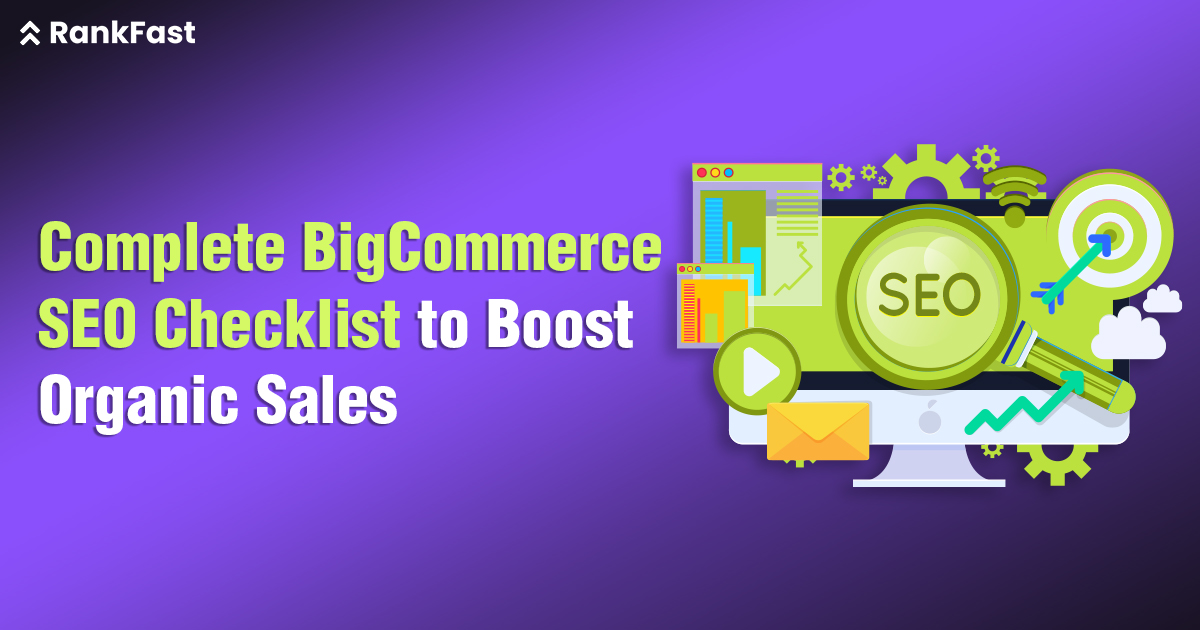
Leave a Reply